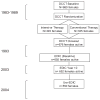Urinary incontinence among women with type 1 diabetes--how common is it?
- PMID: 19152930
- PMCID: PMC2696131
- DOI: 10.1016/j.juro.2008.11.024
Urinary incontinence among women with type 1 diabetes--how common is it?
Abstract
Purpose: We compared the prevalence, level of bother and effect on daily activities of urinary incontinence among women with type 1 diabetes enrolled in the Epidemiology of Diabetes Interventions and Complications study to a population based sample of women with normal glucose.
Materials and methods: We performed a cross-sectional analysis of women with type 1 diabetes and normal glucose tolerance using 2 study populations. The Diabetes Control and Complications Trial cohort followup, Epidemiology of Diabetes Interventions and Complications, began in 1994. In 2004 women participants (550) completed a self-administered questionnaire on urinary incontinence. Our primary outcome was weekly or greater incontinence, overall and by type. Prevalence of urinary incontinence was compared to a subgroup of women with normal glucose in the 2001 to 2002 National Health and Nutrition Examination Survey (NHANES).
Results: Overall 65% of women with type 1 diabetes reported any urinary incontinence (17% reported weekly incontinence). Nearly 40% of these women were greatly bothered by their incontinence and 9% believed it affected their day-to-day activities. Women with type 1 diabetes had a nearly 2-fold greater prevalence of weekly urge incontinence compared to those without diabetes in the NHANES cohort (8.8% vs 4.5%, p = 0.01).
Conclusions: Urinary incontinence is common in women with type 1 diabetes and the prevalence of weekly urge incontinence is far greater compared to that in women with normal glucose levels. Moreover, the prevalence of urinary incontinence in women with type 1 diabetes was greater than that of neuropathy, retinopathy and nephropathy. These findings highlight the importance of screening for urinary incontinence among women with type 1 diabetes. Studies examining factors associated with urinary incontinence in women with type 1 diabetes are warranted.
Figures
References
-
- Hunskaar S, Arnold EP, Burgio K, Diokno AC, Herzog AR, Mallett VT. Epidemiology and natural history of urinary incontinence. Int Uro-gynecol J Pelvic Floor Dysfunct. 2000;11:301. - PubMed
-
- Samuelsson E, Victor A, Tibblin G. A population study of urinary incontinence and nocturia among women aged 20–59 years. Prevalence, well-being and wish for treatment Acta Obstet Gynecol Scand. 1997;76:74. - PubMed
-
- Lifford KL, Curhan GC, Hu FB, Barbieri RL, Grodstein F. Type 2 diabetes mellitus and risk of developing urinary incontinence. J Am Geriatr Soc. 2005;53:1851. - PubMed
-
- Jackson SL, Scholes D, Boyko EJ, Abraham L, Fihn SD. Urinary incontinence and diabetes in post-menopausal women. Diabetes Care. 2005;28:1730. - PubMed
-
- Brown JS, Vittinghoff E, Lin F, Nyberg LM, Kusek JW, Kanaya AM. Prevalence and risk factors for urinary incontinence in women with type 2 diabetes and impaired fasting glucose: findings from the National Health and Nutrition Examination Survey (NHANES) 2001–2002. Diabetes Care. 2006;29:1307. - PMC - PubMed


